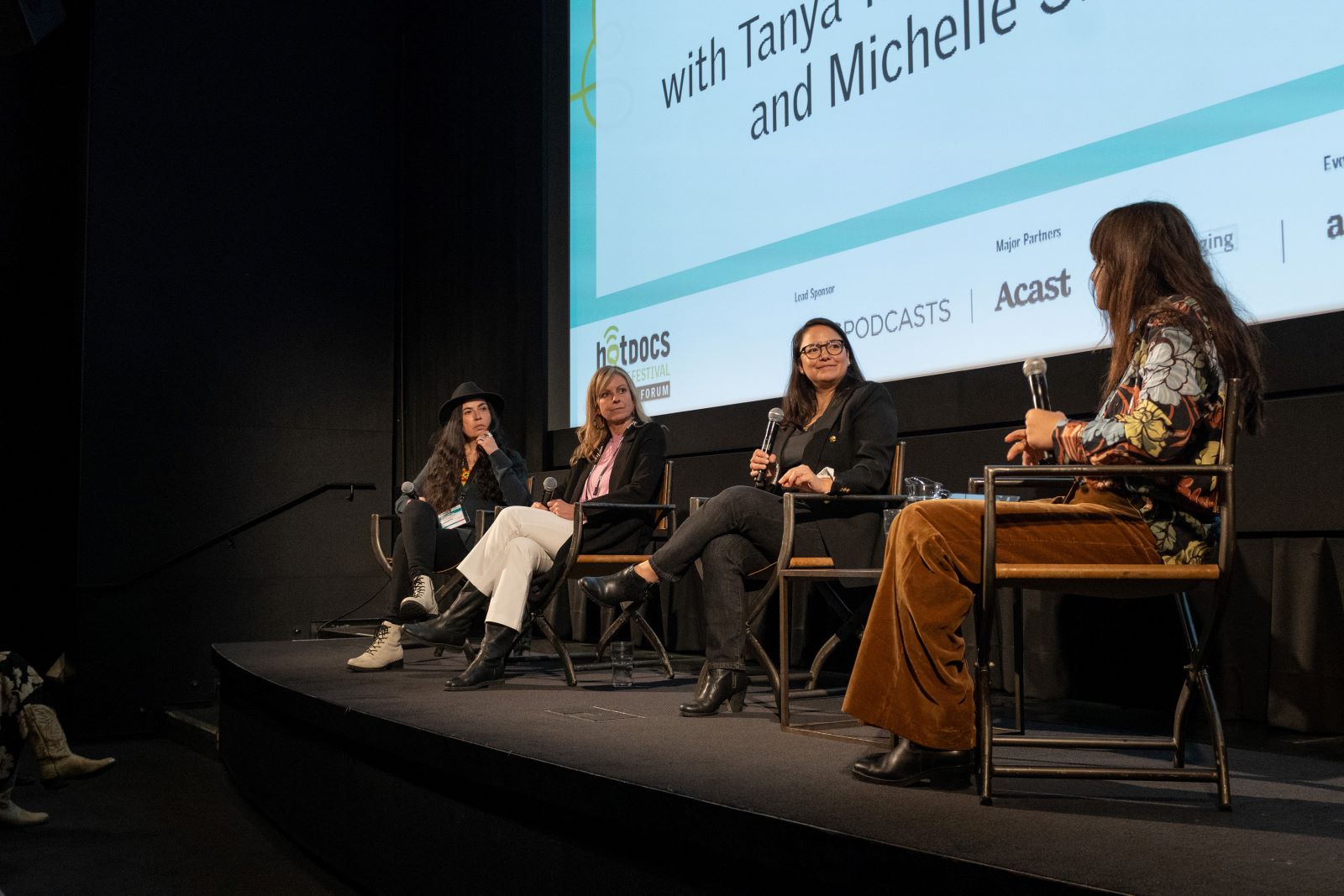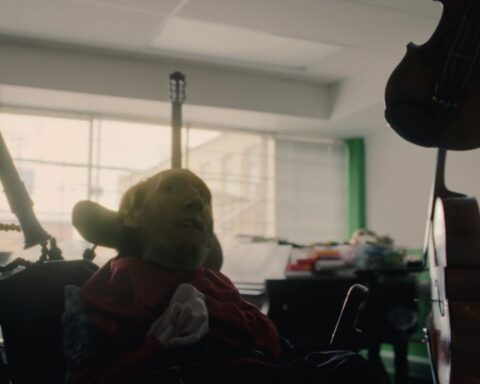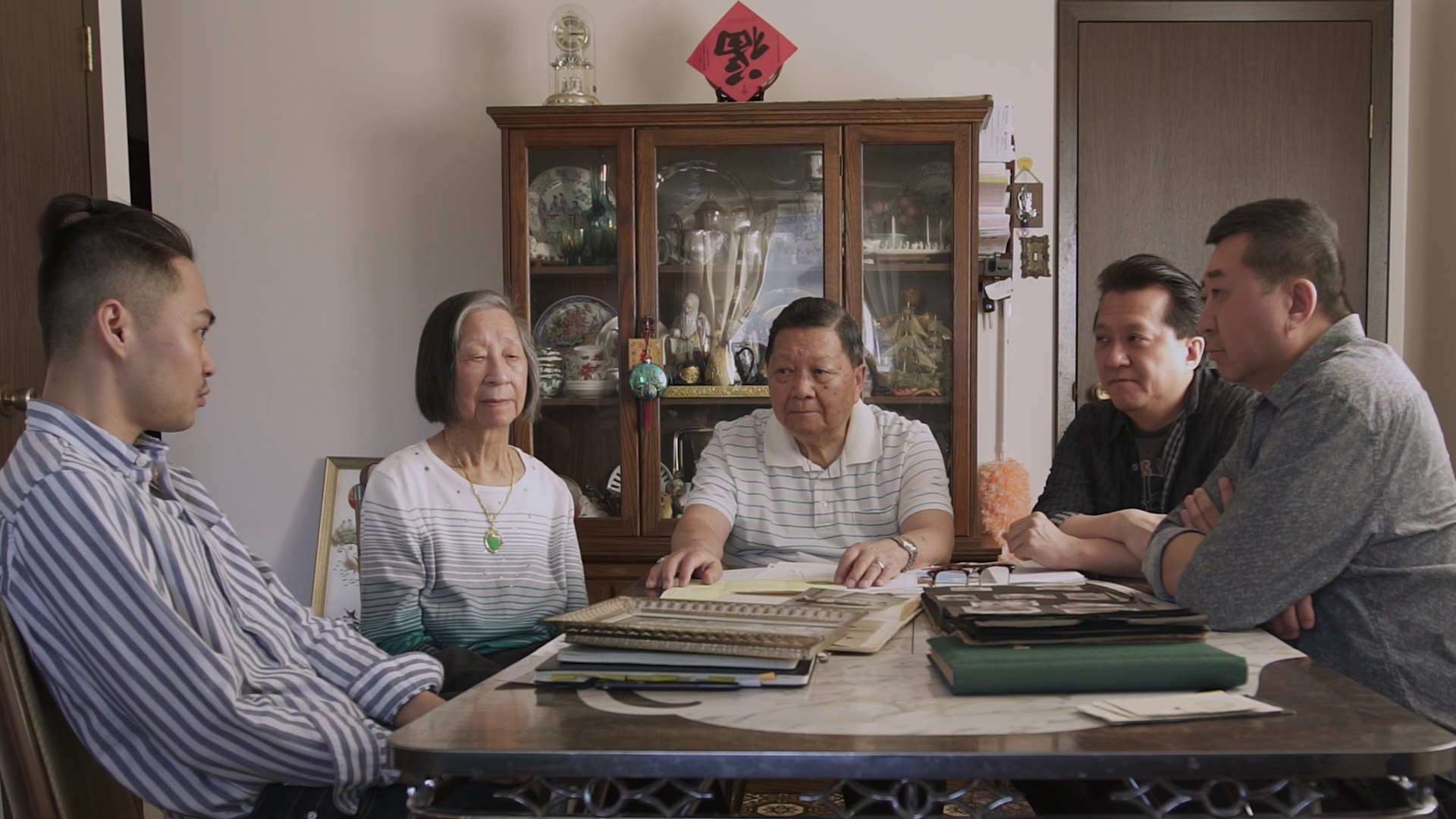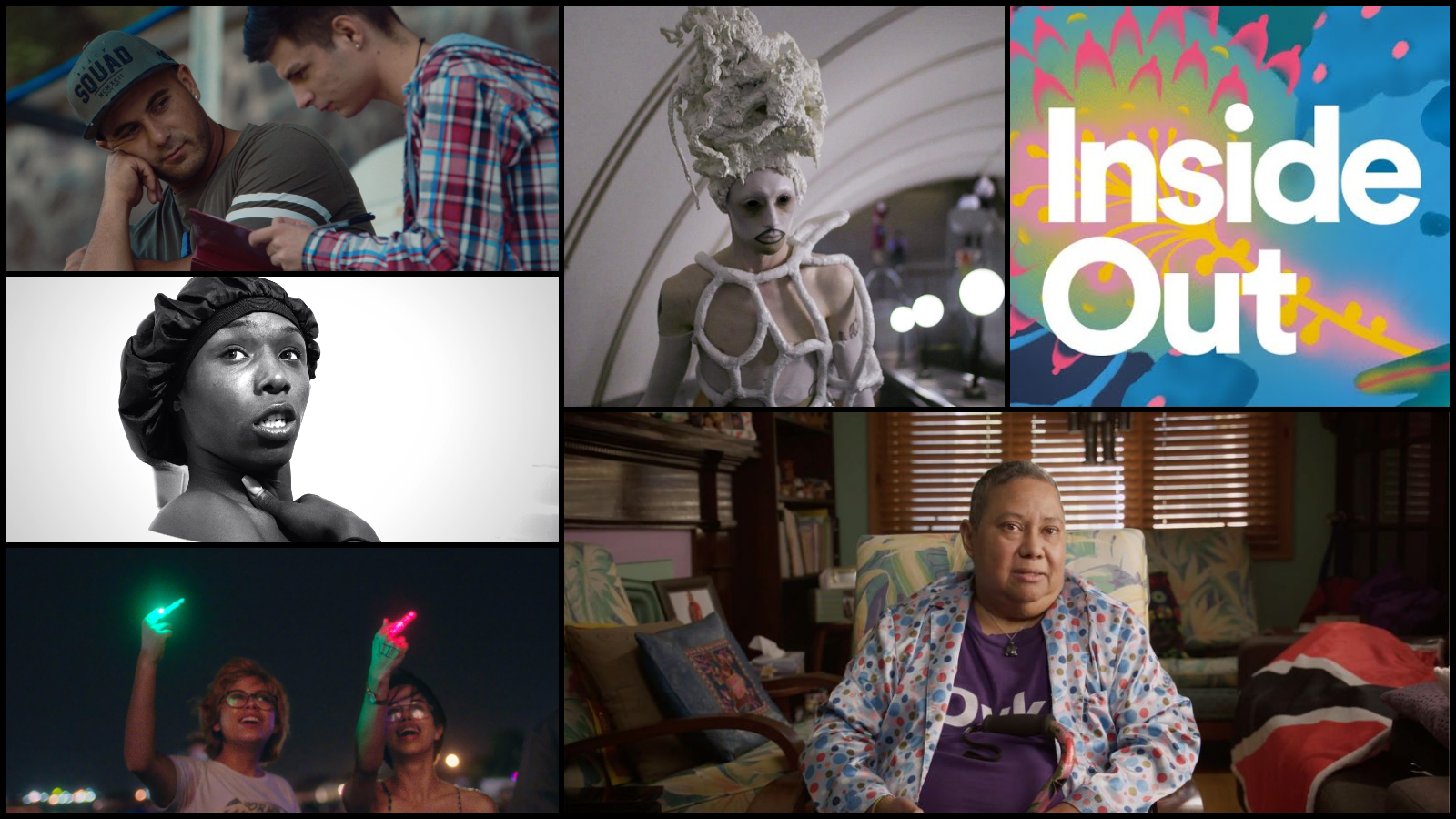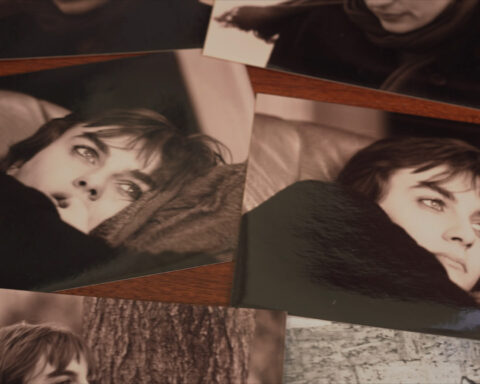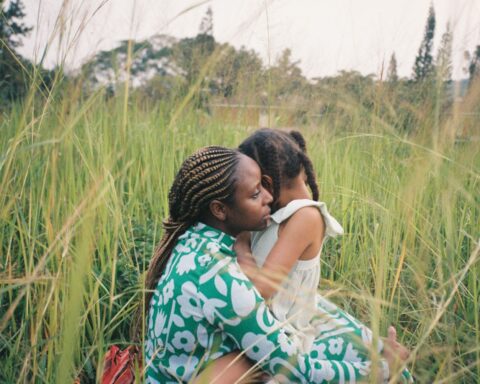In celebration of its 30th anniversary, Hot Docs conceived and produced its inaugural Podcast Festival Showcase, a series of presentations, conversations and live episodes from such stalwarts as CBC Podcasts (the presenting partner of the Showcase), WYNC Studios’ Radiolab, New York magazine’s On with Kara Swisher, Wondery’s Scamfluencers, and The Happiness Lab with Dr. Laurie Santos. The Showcase is a spin-off of Hot Docs’ Podcast Festival, which happens every fall in Toronto.
On the Industry Conference side, Podcast Curator Will Di Novi and his team created a solid two-day assemblage of sessions that explored the intersections of, and the artistic differences between, the journalism, documentary and podcast spheres; the challenges of finding and retaining your audiences; and the joys and pains of collaborations among media companies.
“Crossing from Docs to Pods with Tanya Talaga, Connie Walker and Michelle Shephard”
Investigative journalist Connie Walker enjoyed a career-defining week in the days after Hot Docs, winning both a Pulitzer Prize for Audio Reporting and a Peabody Award for Podcast/Radio for Stolen: Surviving St. Michael’s, in which she uncovered a story of longstanding abuse of Indigenous children–including her father–at an Indian residential school in Canada. Stolen also won a DuPont-Columbia Award back in January.
Walker joined journalists/podcasters Tanya Talaga and Michelle Shephard and columnist/moderator Amil Niazi to discuss the crossover potential from print journalism to podcasting, and the challenges in adapting to a new medium.
Walker maintained, “I definitely feel that crossing over into podcasting gave me an opportunity to tell the stories that I was interested in—largely about Indigenous people in our communities. We were able to provide a space where people could empathize, in a way to counteract a lot of the stereotypes that have traditionally been in place when hearing stories from our communities.”

Michelle Shephard was an investigative reporter for the Toronto Star for 21 years, earning prestigious awards along the way while gradually venturing into documentary filmmaking, then podcasting after she left the Star in 2017.
Podcasting has opened Shephard’s mind to an expansive frontier for her creative and journalistic ambitions. “When do you ever get an audience for three hours?” she remarked. “For long-form narrative stories, you really can get into the weeds. And what I especially love about it is, you can explain the journalism as we go along.”
Tanya Talaga, now a columnist with the Toronto Globe and Mail, and previously a journalist with the Toronto Star, has been creating both podcasts and documentaries since 2020—mainly about Canada’s dark history of systemic racism and its difficult path towards reconciliation. “I find that I’m a journalist first, and I just have all these other mediums that I work in,” she asserted. “To me pushing out the story is why I do this. We work for our communities, as I do as an Anishinaabe journalist.”
Once you know you’re on to a good story, how do you transform it into a good podcast?
“If you have a sense of the journey,” Walker explained. “Part of the thinking is, ‘What is the compelling question that is propelling you forward in the investigation?’ With some mediums, it’s easier, and you have more space to help you find the best way to amplify someone’s story or their voice. With podcasting, you can get to know people in a different way and really provide more opportunities for [audiences] to get to know them on different levels.”
“It’s hit and miss sometimes,” Shephard added. “A podcast often is the most complicated story, because you do have that time and space to investigate and explain, maybe go down this alley and come back this [other] way.”
“We’re all journalists who write,” Talaga explained. “So we know what a story is, and we know what to pursue. And as a writer, you can go into your mind. And when you’re writing the script, or thinking about what’s out there, instead of writing what sounds look like, you can actually get sounds, like water or wind, to make your podcasts come alive to Indigenous storytellers.”
The audio medium, of course, eliminates the need for a camera and minimizes the potential for performative self-awareness that a camera can spark among participants. “People change on camera; it’s a really hard thing,” Shepherd noted. “Whereas with audio, people forget the microphones are there very quickly. It’s closer to what you get when you’re doing written work, and you’re just having a conversation with someone.”
One challenge all three panelists discussed was what happens when you host a podcast. Suddenly, you become a character in the story, a breach in old-school journalism protocol, where reporters distance themselves to let the story unfold. In podcasting, the journalist is a necessary presence as the conduit between the story and the audience.
“Even on podcasts that aren’t personal, you’re still very much a personality,” Shephard admitted. “And it’s hard to get over that. That’s when your team can say, ‘We need a little bit more of you here.’ You really are important…because for someone to devote that much time to listening to your series, they have to know you a little bit. And they have to like you.”
“It’s been an evolution, just in terms of how comfortable I feel being in a story,” Talaga added. “and how comfortable you are being the guide for the person. It feels like you are the standard for the audience.”
That said, the participants in a podcast are accorded the same degree of duty of care as they would in a documentary. “I remember wanting to be really careful and protect them,” Walker recalled. “I felt like it could be harmful to tell their story. And what they taught me was how it was actually healing and empowering for them when they were given agency in the telling of their own story.”
“It’s always that balance, how you respect the people that matter: Your listeners, and how those who are telling stories,” Shephard asserted.
As far as breaking into podcasting, “You really have to believe in yourself and your passion for something,” Walker maintained. “I’ve always been interested in telling stories about our communities; there needs to be this space. Podcasting is radio, and radio has been such a big part of all of our lives, and it’s not going away; it’s just changing form. So just get a good story.”
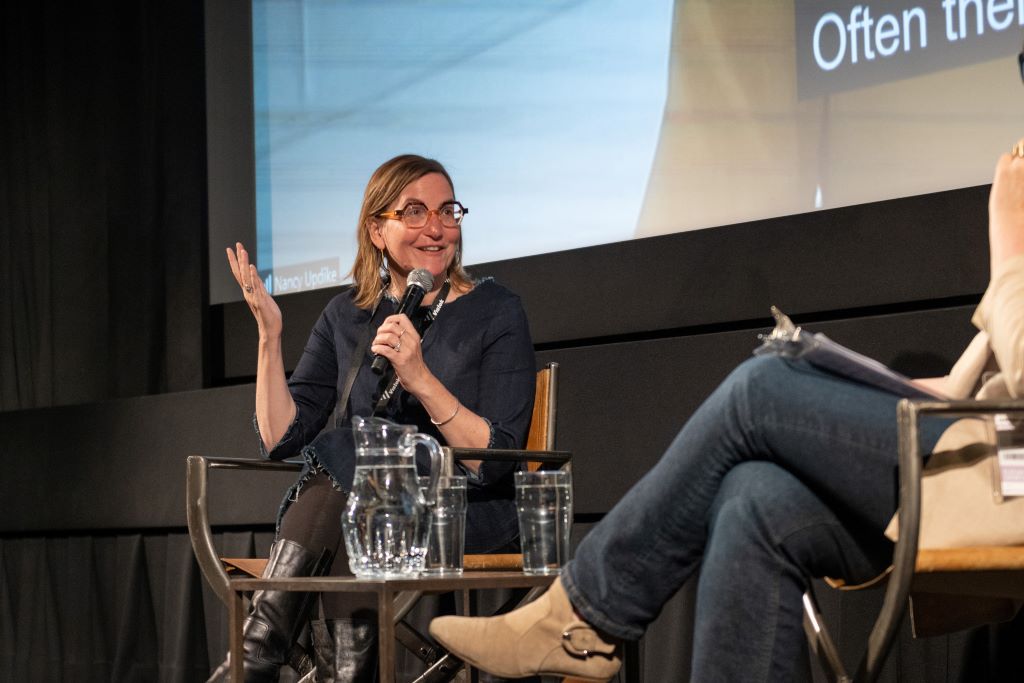
“Intimate Epics” A Storytelling Masterclass with This American Life’s Nancy Updike and Oscar Nominee Nicole Newnham”
Nancy Updike, one of the great originals at the podcast prototype This American Life, has never made a documentary, while Nicole Newnham, who was at Hot Docs with The Disappearance of Shere Hite, has never made a podcast. But the Industry Conference team brought the two together for moderator/The Globe and Mail entertainment columnist Johanna Schneller to find some common ground in their processes.
Updike shared that she knows she’s on to something when she has “a lot of questions about the subject, or I want to go to this particular place and see this process unfold.” Newnham realizes how much time has elapsed since she first started fleshing out her idea, and ”then I realize it’s taken hold of me and I just can’t stop. Something about this narrative has the potential to change the way that I see something and bring me to a more profound understanding.”
“There is a kind of wholeheartedness to coming into a project and seeing all these parts of it refracting in your mind,” Updike elaborated. “I’m thinking about the story that I’m digging into, the people in that story…and what more I want to learn. It feels very immersive.”

Once you have found your story, you need protagonists who have lived this story and who have agreed to share it with you. “I ask questions from an honest place,” Updike explained. “It’s a particular kind of relationship that requires time, attention and integrity.” For Newnham, “I usually try to get to know the person pretty well before filming or interviewing. I think of a Venn Diagram overlap between what I’m interested in and what their interest in having the story told is, and assure them of my partnership with them around that.”
Updike explained, “Part of what I do is tell people, ‘You don’t have to answer any questions; you can say you don’t want to talk about it. I do very long interviews for a lot of the stories I do and part of the process is bringing out in the open questions that I have based on their answers…Then feel more comfortable putting things in the story.”
“Podcasts and Op-Docs at The New York Times: Meet the Decision Makers”
When The New York Times launched its Op-Docs division in 2011, it arguably ushered in a cavalcade of platforms for the short documentary form. Many titles in the Conde Nast portfolio, such as The New Yorker, came on board, producing video endeavours, as have The Guardian, Los Angeles Times and other legacy publications. Since the epochal Serial podcast enthralled a nation of listeners in 2014, those publications, along with public radio and so many other platforms, have embraced this dynamic form of storytelling.
Hot Docs invited Ranan Borelli, the Times’ Deputy Audience Director for Audio, and Christine Kecher, Senior Commissioning Editor for Op-Docs, for a conversation with podcast/journalist Hannah Song.
Borelli and his team handle the digital elements for the Times‘ slate of podcasts, posting them on the company’s website and major podcast platforms and most importantly, identifying and reaching the listening audience. “You need to have a far more diversified portfolio of where you are programming and where you’re putting out your shows. You don’t know where the audience is gonna come from, so we have to coordinate across a half-dozen different teams and constituencies to make sure that the stuff that we’re creating is actually reaching the audience we want to reach. We have to think about how we’re framing things to our audience, and hopefully…beyond. So my job is to think about how it’s going to get to everywhere that it needs to go, and understanding the web at large, and how it works.”
On the Op-Docs side, Kecher and her team acquire and program about 25 short documentaries per year, all created by indie filmmakers, which are posted on the Times home page. And since the Op-Docs division is housed in the Opinion department, “We try to show people the human side of the news. So it’s a lot of character-driven [work], very cinematic, a lot of festival films.”

With the Times’ podcasts, Borelli appreciates the deeper context the form lends to the reported stories, giving a real transparency to the journalistic process: “You can really see somebody practicing their craft and see how hard the work is to get answers out of people, how to deal with a hostile interviewee or how putting these stories together actually works.”
For Kecher, transparency about the process isn’t so much the driving aim; her division seeks out content to amplify what the Times has not covered. “What can filmmakers bring to us that we’re not seeing, or we’re not covering? We can’t be everywhere all the time. So it’s really amazing to see the stories that we had no idea about.”
For both Kecher and Borelli, fact-checking is essential. “You have to weigh how important this story is versus how absolutely airtight you are, in fact-checking,” Kecher noted. “It just encourages all of us to think about, ‘Where are the potential failures? How do we get better at that?’”
“When we are thinking about all the shows that we’re putting together, the processes and structures that we have in place are everything that we can do to try to guarantee the accuracy and the quality of our product,” Borelli added. “My team is reading all the emails that come in for The Daily or any of our shows, and we are in constant conversation with the standards team for any questions or corrections that we need to make. Part of being a good journalist is holding yourself accountable, both on the front end, and on the back end.”
The listeners and viewers–where to find them, how to reach them, how to sustain them–is a constantly morphing endeavor for both Borelli and Kecher. “Our audience team is always learning from every part of the Times–strategies, what’s worked and what hasn’t,” Kecher explained. “We’re always evolving with each other. The analytics are never quite as good as you wish they were. But they’re always improving. The homepage and newsletters drive the biggest proportions of our traffic. The algorithm is a bit of a mystery, but we’ve had films go to four million views in a couple of weeks. And then other films will build up to millions of views, but over a very long period of time.”

“Nonfiction without Borders: A Co-production Case Study with the Los Angeles Times and CBC Podcasts”
When two media giants collaborate, huge things happen, for better or worse. When that collaboration crosses borders, the logistics and bureaucracies pose challenges in efficiencies, streamlining and economies of scale. But international co-productions can work. When Jazmin Aguilera, Head of Audio at Los Angeles Times, reached out to Arif Noorani, Director of CBC Podcasts, about working together on Pulitzer Prize winning journalist Ian Urbina’s The Outlaw Ocean podcast, the creative executives knew they were in for a big adventure.
When Urbina first approached Aguilera about his project, which he had been immersed in for several years, he had already pitched to CBC. He sought out advice from Aguilera about where he should go from there, and what the podcast industry looked like. She was interested, and also saw the potential for a bigger investment in the project if CBC were involved.
Noorani welcomed the idea. “What I love about podcasting is the spirit of generosity and collaboration across companies and makers. We work with BBC, NPR and a whole range of folks. Everyone who’s in the podcasting part is really open to lifting the whole industry. What we’re trying to do is grow the audience overall.”
Even though the two companies had not worked together before, Aguilera and Noorani respected each other’s work. “I actually am way more into the idea of doing partnerships like this because of [the success of] this partnership,” Aguilera maintained.
But the Los Angeles Times and CBC are corporations, and partnerships of this sort attract the suits. “It really comes from that spirit of ‘Don’t let the corporations take over,’” Aguilera noted. “Because then you’ll get into that legal vortex. That’s what made this work: It was us, and people that believed in the project.”
“We’re both indie at heart,” Noorani concurred. “We were within these big media companies, but we operate with more of the spirit of an independent startup. That’s what you need to get these co-productions across the finish line.”
In a landscape of five million podcasts, Noorani continued, “The way to stand out is to partner and leverage and find new audiences.”
Given that it was an international co-production, the legal and administrative pieces were more complicated and layered, especially when it came to insurance. It took months of meetings and constant communication between the two creative executives to ensure some degree of fluidity.
CBC hosted The Outlaw Ocean, while crediting and splitting ad revenue with the Los Angeles Times. “I knew that even if it was not in the best interest of the Times, it would be better for the podcast to be on a CBC feed,” Aguilera admitted. ” So I was able to make that concession. And then we were able to negotiate trades…which helped with my other podcasts.”.
For indie podcasters considering partnerships with media companies, Aguilera and Noorani advised to budget for insurance before you pitch, and Noorani suggested that each side engage an advocate–a “project whisperer,” as he dubbed it, who will educate you on areas like liability and contracting. Noorani went on to spell out the essential components to a successful podcast: story editors; sound design and mixing; social and digital strategy; and audience building. He also suggested creating two versions of your pitch: “one for people that have time and one for people who don’t…The other piece of advice is, You really need to have access to a great story that has layers and surprises, that can take us into a whole world.”
“We’re all rivers here trying to find the path,” Aguilera said. “I need to know what the obstacles are to help you get there.”




